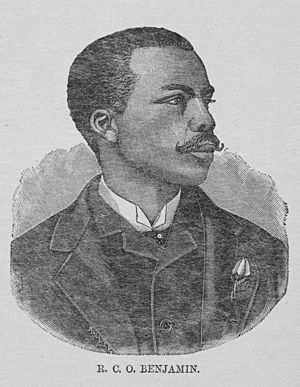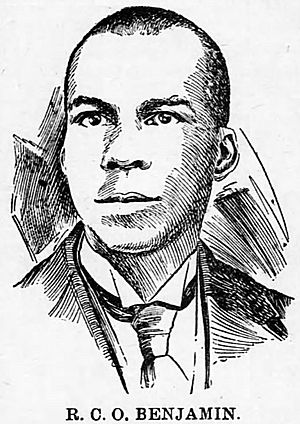R. C. O. Benjamin facts for kids
Quick facts for kids
R. C. O. Benjamin
|
|
|---|---|

Benjamin in 1887
|
|
| Born | March 31, 1855 |
| Died | October 2, 1900 (aged 45) |
| Occupation | Journalist, lawyer, minister |
| Political party | Republican |
| Religion | African Methodist Episcopal |
R. C. O. Benjamin (born March 31, 1855 – died October 2, 1900) was an important American figure. He worked as a journalist, a lawyer, and a minister. He wrote for and edited many newspapers across the country. He might have been the first Black editor of a newspaper mainly for white readers. This happened when he worked for the Daily Sun in Los Angeles.
Benjamin was also possibly the first Black man allowed to practice law in California. He may have been allowed to practice law in as many as twelve different states. In 1900, he was a well-known lawyer in Lexington, Kentucky. He was working to help Black citizens register to vote. Sadly, he was killed that year because of his efforts.
Contents
Early Life and Learning
Robert Charles O'Hara Benjamin was born on March 31, 1855, in St. Kitts. He went to school there until he was eleven years old. After that, he traveled to England for private lessons.
He then studied for three years at Trinity College at Oxford University. He left Oxford without finishing his degree. Then, he spent two years exploring the East Indies, visiting places like Sumatra and Java.
After returning to England, he sailed to New York City. He arrived on April 13, 1869. Ten days later, he went on a six-month trip as a cabin boy. This journey took him to South America and the Caribbean. He visited countries like Venezuela and islands like Curaçao. In the fall of 1869, he came back and settled in New York City.
Starting His Career
In New York, Benjamin met several important people. These included Henry Highland Garnet and Joe Howard, Jr.. He started working for the New York Star newspaper. There, he became friends with J. J. Freeman, who edited the Progressive American. Benjamin soon became the city editor for that paper. Around this time, he also became a citizen of the United States.
In 1876, Benjamin helped with the election campaign for Rutherford B. Hayes. Hayes was a Republican and later won the presidency. Because of his hard work in politics, Benjamin got a job. He became a letter carrier at the New York Post Office.
After nine months, he left that job and moved to Kentucky. There, he taught at different schools and began studying law. He learned from important people like ex-Congressman Reed. He then moved to Decatur, Alabama, where he became a school principal. Later, he moved to Brinkley, Arkansas and then to Memphis, Tennessee.
In Memphis, he kept studying law with the help of Josiah Patterson. With Patterson's help, he was allowed to practice law in January 1880. He was also allowed to practice law in Charlottesville, Virginia, in the 1880s.
Journalist, Writer, and Speaker
Benjamin returned to journalism and owned many newspapers. These included the Colored Citizen in Pittsburgh, Pennsylvania. He also ran the Chronicle in Evansville, Indiana. Another paper he owned was the Negro American in Birmingham, Alabama. He lived in Birmingham for some time.
In Birmingham in 1887, he helped start the Robert Brown Elliot School of Technology. This was the first school of its kind for Black people in the U.S. He also wrote many small books (pamphlets). These pamphlets were about African-American history and important issues.
Benjamin was also a famous speaker. He often spoke out against lynchings and violence against Black people. Because he spoke so strongly, he was forced to leave Brinkley, Arkansas, in 1879. He also had to leave Birmingham in 1887. He was also known as a poet. His poems were included in a collection of African American poetry in 1992.
Time in California
In 1887, Benjamin moved to California. There, he worked as an editor for the Los Angeles Observer and the San Francisco Sentinel. For a while, he was the local editor of the Daily Sun in Los Angeles. The Sun was a newspaper mainly for white readers. Benjamin might have been the first Black man to edit such a paper.
In California, he became the first Black man allowed to practice law in 1887. He worked as a lawyer in San Francisco. He may have been the first Black lawyer to visit Oregon. It is said that Benjamin was allowed to practice law in 12 states. These states included Virginia, Tennessee, California, Rhode Island, and Alabama.
Later Life and Tragic End
In December 1892, Benjamin married Lula M. Robinson. They had a son and a daughter together. In 1895, while working as a lawyer in Rhode Island, Benjamin was suggested for a special job. He was a minister in the African Methodist Episcopal Church. He was nominated to be a chaplain for the United States House of Representatives.
In 1897, Benjamin, his wife Lula, and their two children moved back to Lexington, Kentucky. There, he edited a newspaper called the Lexington Standard. In 1900, he was a lawyer for Caleb Powers in a major court case.
His Death
On October 2, 1900, Benjamin was killed in Lexington. He was helping Black citizens register to vote. That day, he spoke to a white man named Michael Moynahan. Moynahan was bothering a group of Black men who were trying to register. Moynahan hit Benjamin with a gun and was arrested.
When Moynahan was released from jail that evening, he went to Benjamin's house. He waited for Benjamin to come home. When Benjamin arrived and saw Moynahan, he tried to run away. Moynahan then shot Benjamin six times in the back. At his trial, Moynahan said he acted in self-defense, and the case was dismissed.
Benjamin was buried in Lexington's African Cemetery No. 2. In 1910, a monument was placed at his grave to honor him.
See also
- List of first minority male lawyers and judges in California


